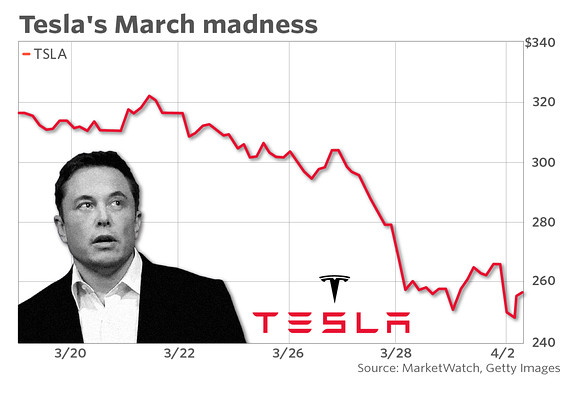Why is Tesla losing market share?

Why is Tesla losing market share? ChatGPT Tesla has long been a leader in the electric vehicle (EV) industry, known for its innovative cars and cutting-edge technology. However, in recent times, Tesla has been losing market share to competitors. There are several reasons for this shift, and understanding these factors can provide insights into the broader dynamics of the EV market. Let's explore why Tesla is losing market
Tesla has long been a leader in the electric vehicle (EV) industry, known for its innovative cars and cutting-edge technology. However, in recent times, Tesla has been losing market share to competitors. There are several reasons for this shift, and understanding these factors can provide insights into the broader dynamics of the EV market. Let’s explore why Tesla is losing market share.
1. Increased Competition
One of the main reasons Tesla is losing market share is due to increased competition. Many automakers have entered the EV market, offering a range of electric vehicles that cater to different consumer needs. Companies like Ford, General Motors, Volkswagen, and Hyundai have made significant investments in EV technology, releasing models that directly compete with Tesla.
- Ford’s Mustang Mach-E: This vehicle has been praised for its performance and design, attracting consumers who might have considered a Tesla Model Y.
- Volkswagen ID.4: Volkswagen’s push into the EV market with the ID.4 and other models has been well-received, offering a more affordable option for buyers.
According to a report from CNBC, Tesla’s market share in the United States fell from 79% in 2020 to 65% in 2022. This decline is largely attributed to the growing number of alternative EV options available to consumers.
2. Diverse Product Offerings from Rivals
While Tesla has focused on a few core models like the Model S, Model 3, Model X, and Model Y, other automakers are offering a wider variety of vehicles to appeal to different market segments. From compact cars to electric trucks and SUVs, competitors are providing consumers with choices that Tesla does not.
- Hyundai Ioniq 5: This model has gained attention for its futuristic design and features, targeting tech-savvy buyers.
- Rivian R1T: Rivian’s electric truck appeals to adventure-seekers and those interested in rugged vehicles.
Tesla’s limited lineup may not appeal to all potential EV buyers, especially those looking for specific types of vehicles. This variety from other manufacturers allows them to capture segments of the market that Tesla hasn’t fully addressed.
3. Pricing and Affordability
Another factor contributing to Tesla’s loss of market share is pricing. While Tesla vehicles are known for their technology and performance, they tend to be on the higher end of the price spectrum. With the introduction of more affordable EV options from competitors, consumers now have choices that fit different budgets.
- Chevrolet Bolt: Priced significantly lower than the Tesla Model 3, the Bolt offers an accessible entry point for those looking to switch to electric vehicles.
- Nissan Leaf: As one of the more affordable electric cars, it continues to attract budget-conscious buyers.
These more affordable alternatives make it easier for consumers to transition to EVs without the financial burden of a high price tag, drawing potential Tesla customers towards other brands.
4. Quality Control Issues
Tesla has faced criticism over quality control and reliability issues, which have impacted consumer perception. Reports of inconsistent build quality, software glitches, and recalls have led some buyers to consider other brands known for their reliability.
- Quality Concerns: Some Tesla owners have reported issues with paint, panel alignment, and interior materials, which can deter potential buyers.
- Recalls: Tesla has had several recalls, including those related to software updates and hardware malfunctions.
These quality concerns can influence a buyer’s decision, leading them to consider alternative brands with a reputation for consistency and dependability.
5. Global Market Dynamics
Tesla’s market share is also influenced by global dynamics, including regulatory changes and market conditions in different regions.
- China’s Market: In China, one of the largest EV markets, Tesla faces competition from local manufacturers like BYD and NIO, which offer products tailored to local preferences and often at competitive prices.
- European Regulations: European countries are promoting EV adoption with incentives, and Tesla’s competitors are rapidly expanding their presence in these markets, offering vehicles that meet local emissions standards and preferences.
These regional factors can affect Tesla’s ability to maintain its market dominance as competitors become more adept at addressing local market needs.
6. Tesla’s Response and Future Prospects
Despite losing some market share, Tesla remains a formidable player in the EV industry. The company continues to innovate, expanding its Gigafactories and investing in new technologies such as Full Self-Driving (FSD).
- New Models: Tesla is planning to introduce new models like the Cybertruck and Roadster, which could rejuvenate interest and attract new customers.
- Battery Technology: Advancements in battery technology and production capabilities could enhance Tesla’s competitiveness in the long run.
Tesla’s ability to adapt to these challenges and leverage its technological strengths will be crucial in determining its future position in the market.
Conclusion
Tesla’s loss of market share can be attributed to a combination of factors, including increased competition, diverse offerings from rivals, pricing challenges, quality issues, and global market dynamics. However, with its strong brand recognition and continued focus on innovation, Tesla remains well-positioned to navigate these challenges. Understanding these dynamics helps investors, consumers, and industry observers appreciate the complexities of the evolving EV landscape.